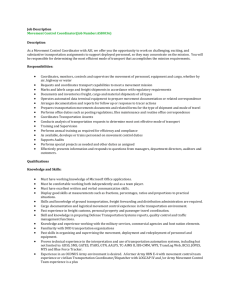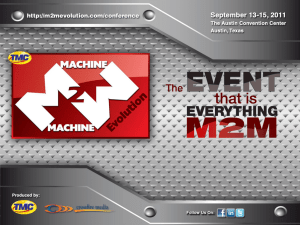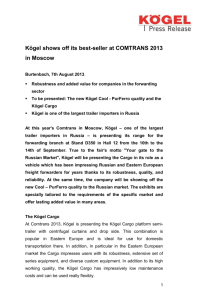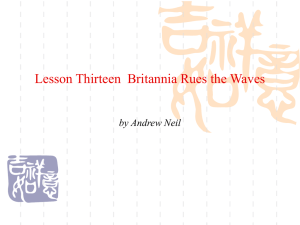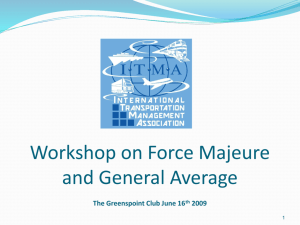TRANSPORT
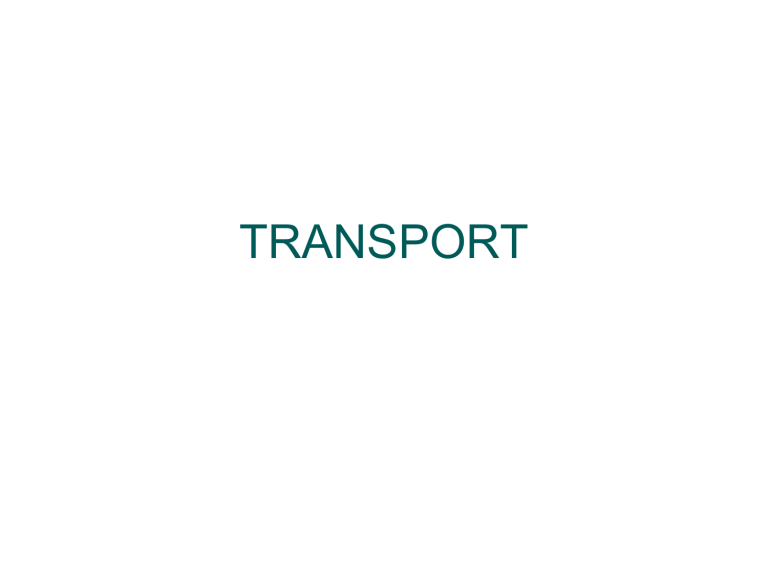
TRANSPORT
• According to the means chosen,
• goods can be transported:
• by land (rail or road)
• by sea
• by air
• pipelines
Italian export trade according to means of transport used
Road 25%
Rail 6%
Air 2%
Other 6%
Water
Road
Rail
Air
Other
Water 61%
• The choice of the method of transport depends on 6 fundamental factors:
1. type of goods (valuable, fragile, durable or perishable goods)
2. distance involved
3. speed and security of transport
4. cost involved
5. urgency of the order
6. dimensions (size and weight)
Transport by Road
used for the transportation of goods over short distances
• DISADVANTAGES
•
ADVANTAGES :
CHEAP AND FLEXIBLE
1.
door-to-door service
1.
Cost and possible delays
• expensive and subject to
2.
no rigid timetables delays caused by traffic and
3.
routes can be changed at the very bad road conditions over long last moment
distances;
4.
the same vehicle can be used for different deliveries
2.
risk of road accidents;
5.
suitable for fragile goods (these are in fact loaded and unloaded just once)
3.
The volume of the cargo is limited.
6.
a quick means of transport inside the EU because lorries are not inspected when they cross the borders of the countries belonging to the Union.
Transport by Rail
used for the transportation of goods over long distances
ADVANTAGES:
1.
cheaper and faster than road transport
2.
suitable for bulky cargoes
(e.g. coal, chemicals, steel, cars)
3.
not subject to bad weather or traffic conditions
DISADVANTAGES:
1) Lack of flexibility (schedules, terminals and routes are fixed)
2) Risk of theft
3) Uneconomical rates over short distances and for small shipments
4) delays due to strikes and other labour problems
TRANSPORT BY AIR
ADVANTAGES :
•
1.
SPEED OF DELIVERY
It is the fastest means of transport over long distances.
•
2.
REDUCTION OF RISKS
The cargo spends little time in transit, so the risks of damage and theft are comparatively lower.
3.
Particularly suitable for : a.
Small consignments of high value; b.
Perishable goods that cannot spend a long time in transit without getting damaged (flowers, food etc.); c.
delivery of emergency items (i.e. medicines, spare parts etc.)
DISADVANTAGES
•
1.
Dimensions
The cargo has volume and weight limitations
•
2.
COST
Air carriage is still the most expensive method of transportation.
•
•
3.
LACK OF FLEXIBILITY
Air transport does not offer a doorto-door service but ... it depends on other forms of transport to and from the airport.
•
•
•
•
4.
DELAYS
It may be delayed by: bad weather labour strikes technical problems border controls
TRANSPORT BY SEA
The most important form of transport in international trade
ADVANTAGES :
1. VERSATILITY (modern ships can accommodate very different types of cargo: from small parcels to bulky cargoes that could not be carried by any other means of transport
2. COMPETITIVE COSTS
• Over the same distance , sea freight is lower than land and air freight.
3. TERMINAL FACILITIES
• Modern ports are equipped:
• with safe and quick loading and unloading facilities and ...
• are connected with rail and road terminals for the further conveyance of the goods.
DISADVANTAGES
1. SLOWNESS
•
If compared with other means of transport, sea transport is surely slower
2. NUMBER OF MOVES
• Cargo must be transhipped many times;
• In other words, goods must be loaded and unloaded several times when the departure and arrival points are not harbour cities.
3. LACK OF FLEXIBILITY
•
Sea transport does not offer a door-todoor service and, apart from non conference liners, is subject to fixed timetables and routes.
4. RISKS OF ACCIDENTS
•
Pollution of the environment (sea pollution) due to sinking or fire of the ship is the most serious problem connected with this form of transport .
Classes of ships
Conference liners
• owned by companies which have reached an agreement over freight rates (i.e. transport tariffs) and therefore are not in competition with each other.
• over the same distance they charge the same freight.
• they sail on fixed dates and follow fixed routes.
• they carry goods belonging to different exporters:
• cargo space can be hired at the company’s offices around the world.
Non – conference liners
(also called tramp ships)
• owned by ship owners in competition with each other who charge freight rates according to:
• type of cargo;
• distance to be covered;
• conditions of the market
(following the law of supply and demand);
• rates may be lower than those charged by conference liners, but standards of safety, security and reliability are not as those offered by conference liners.
Types of cargo ships
• General Bulk Carriers
• ( also called General cargo Carriers)
• can transport any type of goods
• They have:
1. refrigerated compartments for perishable goods,
2. built-in thanks for liquids,
3. holds for:
• vehicles,
• containers,
• non containerised cargoes.
Container ships
• specialised in the transportation of containers
• main advantage of this kind of ship:
• the loading and unloading operations are quicker:
• only one day instead of the usual 5/6 days.
Roll on – Roll off Ships
• carry vehicles that are driven onto and off the ship,
• main advantage:
• In this way the loading and unloading operation have been completely eliminated.
Transport by Pipelines
used for oil, gas, petro-chemicals and some solids, e.g. coal and wood chips (suspended in liquid)
• Advantages
• cheap to operate and maintain;
• safe method of transport
• elimination of geographical obstacles
• not affected by bad weather or traffic conditions
• Disadvantages
• Very high capital costs ( expensive to build)
• Slow (average speed
- 3 miles per hour)
• Fixed routes
• Only certain type of goods can be transported
FREIGHT RATES
IN SEA TRANSPORT
• Space is very important in sea transport.
• Freight rates /tariffs are therefore calculated taking into account mainly:
• the size of the cargo.
• other factors that are sometimes taken into consideration are:
• the weight;
• the rate of risk of the goods (e.g. tariffs may be higher for inflammable goods);
• the value of the shipment .
• Freight rates may be paid by the exporter if the inco-term agreed on is CIF or CFR or it may be paid by the importer if the inco-term is
FOB or FAS .
TRANSPORT DOCUMENTS
• All transport documents have a double function
• they serve as:
1. a receipt for the consignment of goods ( i.e. the goods are under the carrier’s responsibility.
2. a contract of carriage between sender and carrier. they are legally binding documents by which:
• the carrier undertakes to transport the goods in the same condition as he has received them
• the sender agrees to pay the carrier for such a service.
TRANSPORT DOCUMENTS
TRANSPORT BY LAND
INTERNATIONAL ROAD CONSIGNMENT NOTE or
CMR (acronym for Convention des Marchandises par Route)
(Lettera di vettura internazionale)
• Form filled in by the carrier in three copies.
• It contains:
1. names and addresses of : a. consignor b. consignee c. carrier
2. a description of the goods
3. date and place of their departure
4. place of their arrival
4. carriage rates
• A copy is given to the consignor as a receipt stating that the goods have been placed under the responsibility of the carrier. Another copy is given to the consignee, and a third one is kept by the carrier
• In case of claim for damage or loss, the International Road
Consignment Note is the reference document.
TRANSPORT DOCUMENTS
TRANSPORT BY RAIL
THE RAILWAY CONSIGNMENT NOTE
(Lettera di Vettura Ferroviaria)
• document stating that the goods are under the responsibility of the rail authorities.
• obtained from a local station and made of several copies that are given to all the parties involved: consignor, consignee, customs authorities, departure and arrival stations.
• the original copy travels with the goods and will be given to the consignee when he collects them.
• another copy is given to the consignor as a receipt stating that the goods have been entrusted to the rail authorities and a contract of carriage has been drawn up.
• It contains
1. names and addresses of:
• consignor
• consignee
2. a description of the cargo (kind of goods, number of packages, weight etc.)
3. carriage charges
4. stations of departure and arrival
TRANSPORT DOCUMENTS
TRANSPORT BY SEA
The Bill of Lading
(Polizza di carico)
It is:
1. a contract between the exporter and a shipping company:
• It obliges the exporter and the shipper to respect the conditions agreed on and specified in it.
2. a receipt stating that the goods have been loaded aboard a ship and are travelling under the responsibility of the carrier ( i.e. the shipping company).
3. a document of title authorizing the person named in it as the consignee to take possession of the cargo on its arrival.
A Bill of lading always contains the following data :
1. names of consignor (i.e. exporter), carrier and consignee (i.e. importer)
2. name of ship;
3. names of port of departure and arrival;
4. description of the consignment (i.e. the goods being transported);
5. quantity of packages, their markings and numbers; their weight and dimensions;
6. the freight rates ( i.e. the cost of transport).
TRANSPORT DOCUMENTS
TRANSPORT BY SEA
• A B/L can be :
•
Clean or foul/dirty
• In the case of a clean B/L the carrier declares that the goods received were in good conditions.
• In the case of a foul B/L the carrier declares that some damage occurred to the goods before receiving them aboard the ship.
• The exporter who receives a foul B/L cannot obtain payment from the bank.
• To avoid this problem, exporters give a letter of indemnity to the carrier in exchange for a clean B/L.
• In this letter they undertake to meet all claims the importer may place as a result of delivery of damaged goods.
• A Bill of Lading is negotiable :
• it can be endorsed to a new consignee on the conditions fixed by the endorser .
TRANSPORT DOCUMENTS
TRANSPORT BY SEA
Charter Party
• a contract between an exporter and a non-conference shipping company.
• by signing this document, the ship owner places the ship or part of it at the disposal of the charterer.
• a Charter Party can be: a. Time charter b. Voyage charter
• In the first case the ship is chartered for a stated period of time and can effect several voyages;
• in the second case the ship is chartered for one voyage only.
Lay Days
• the number of days necessary to load and unload the goods.
• this number is always stated in a Charter Party.
CONTAINERISATION
(The use of containers in the transportation of goods)
• Containers are large steel boxes, whose size has been internationally agreed.
• They are widely used nowadays to transport goods.
• The reason is due to the fact that goods are easily packed into them and containers travel as sealed units.
• This means that once the goods have been put into them, they are sealed and considered as a single item.
• They will be opened only when they reach their final destination .
• Containers can be transported by land, sea and even by air.
• They are mostly used to transport durable goods, but ...
• there are containers provided with powerful refrigerators which can keep perishable goods fresh for very long periods.
FORWARDING AGENTS
• Experts in the transportation of goods. a. They provide for :
1. the packing
2. the storage of goods
3. the transportation b. They take care of:
• the documentation necessary in international transport
• the insurance of the goods c. They deal with the formalities of international customs d. They are often employed by small companies that haven’t got their own distribution network.
